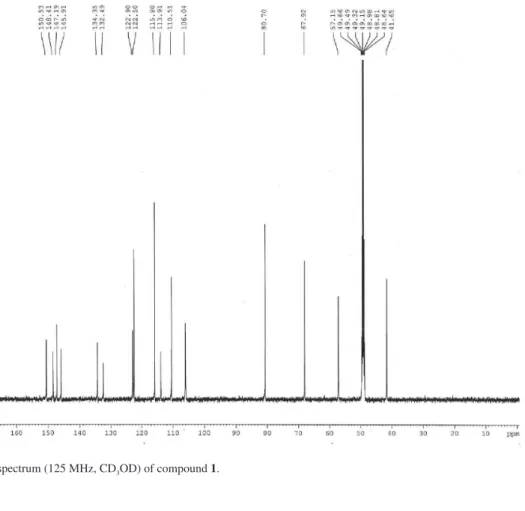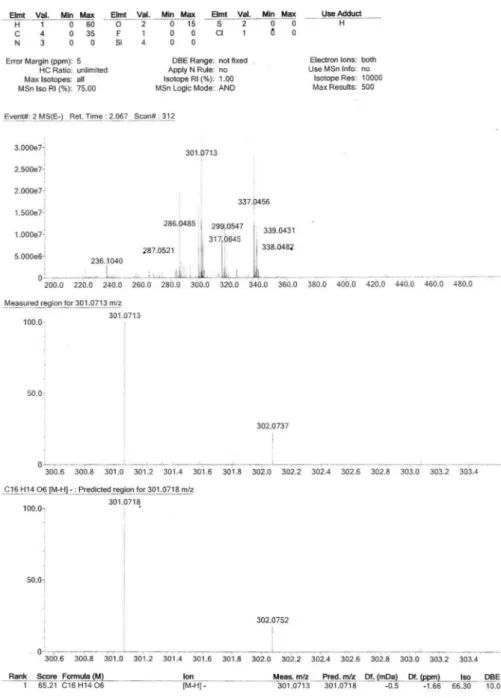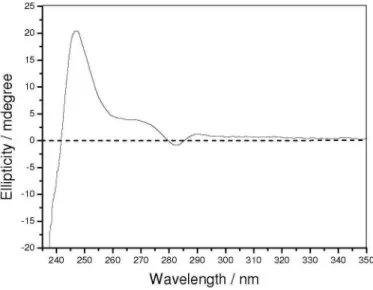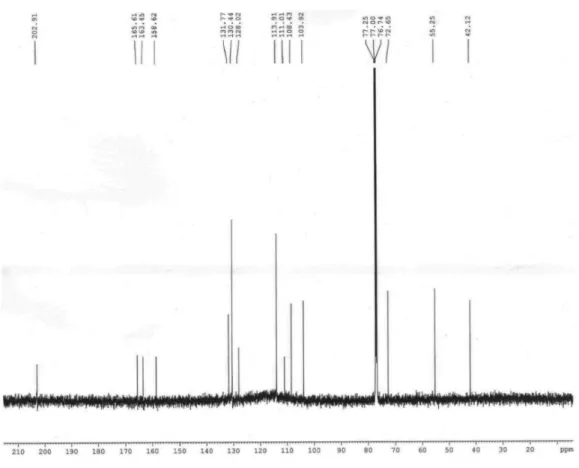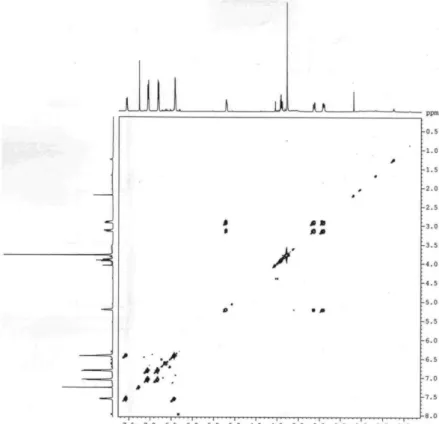Article
J. Braz. Chem. Soc., Vol. 23, No. 7, 1239-1243, 2012. Printed in Brazil - ©2012 Sociedade Brasileira de Química
0103 - 5053 $6.00+0.00
A
*e-mail: mary@dqoi.ufc.br
New Flavonoids and Coumarins from
Platymiscium floribundum
Vogel
Pérsio A. Veloso,a Antonia T. A. Pimenta,a Francisco M. de Sousa,a Maria José C. Falcão,b
Nilce V. Gramosa,a José Nunes da Silva Junior,a Edilberto R. Silveiraa and Mary Anne S. Lima*,a
aDepartamento de Química Orgânica e Inorgânica, Centro de Ciências, Universidade Federal do Ceará, CP 12.200, 60021-940 Fortaleza-CE, Brazil
bDepartamento de Química, Universidade Estadual do Ceará, CP 12.200, 60021-940 Fortaleza-CE, Brazil
Dois novos flavonoides, 3,4,10-tri-hidróxi-9-metoxi-pterocarpano and 2’,4’-di-hidróxi-4’-metoxi-β-hidroxichalcanonol, foram isolados a partir de Platymiscium floribundum, em adição a homopterocapina, 2’,4’,4-tri-hidroxichalcona, 7,3’,5’-tri-hidroxiflavanona, 7,3’-di-hidróxi-8,5’-di-metoxiisoflavanona, 8-hidróxi-5,6,7-tri-metoxicumarina, 6-hidróxi-7,8-di-metoxicumarina, 6,7,8-tri-metoxicumarina, 6,7-di-metoxicumarina, 8-hidróxi-6,7-di-metoxicumarina, 3β -acetóxi-28-hidróxi-olean-12-eno, 1,2,3-tri-metoxi-5-alilbenzeno, 3,4-di-metoxicinamaldeído, e
β-sitosterol e estigmasterol como mistura. A caracterização estrutural de todos os compostos foi estabelecida com base em métodos espectroscópicos, particularmente ressonância magnética nuclear (RMN) 1D e 2D e comparação com dados da literatura.
Two new flavonoids, 3,4,10-trihydroxy-9-methoxypterocarpan and 2’,4’-dihydroxy-4-methoxy-β-hydroxychacanonol, were isolated from Platymiscium floribundum, in addition to the homopterocarpin, 2’,4’,4-trihydroxychalcone, 7,3’,5’-trihydroxyflavanone, 7,3’-dihydroxy-8,5’-dimethoxyisoflavanone, 8-hydroxy-5,6,7,-trimethoxycoumarin, 6-hydroxy-7,8-dimethoxycoumarin, 6,7,8-trimethoxycoumarin, 6,7-dimethoxycoumarin, 8-hydroxy-6,7-dimethoxycoumarin, 3β-acetoxy-28-hydroxyolean-12-ene, 1,2,3-trimethoxy-5-allyl-benzene, 3,4-dimethoxycinnamaldehyde, and β-sitosterol and stigmasterol as a mixture. Structural characterization of all compounds was established on the basis of spectroscopic methods, particularly 1D and 2D nuclear magnetic resonance (NMR) and comparison with data from literature.
Keywords: flavonoids, coumarins, Platymiscium floribundum, Fabaceae
Introduction
Platymiscium floribundum Vog. is a medium sized tree which belongs to the Fabaceae-Papilionoideae family. In the Brazilian Northeast, this plant is popularly known as “sacambu” and “jacaranda-do-litoral” and has been used by the local population in folk medicine as an anti-inflammatory agent.1 In addition, the wood has showed
high commercial value in carpentry.2
Previous chemical investigation of P. floribundum led to the isolation of isoflavonoids and pterocarpans from the heartwood.1 Since then,several activities such as cytotoxic,1
antimitotic3 and apoptosis in HL-60 human leukemia cells4
of the flavonoids have been evaluated.
New Flavonoids and Coumarins from Platymiscium floribundum Vogel J. Braz. Chem. Soc. 1240
Results and Discussion
Compound 1 was obtained as a white solid with mp 108.2-110.0 oC and [α]
D
20 + 272o (CH
3OH, c 0.02).
The IR (infrared) spectrum showed absorption bands at 3379 and 1636 cm-1, characteristic of hydroxyl groups and
aromatic skeleton, respectively. Its molecular formula was established by the negative mode HRESIMS (high-resolution electronspray ionization mass spectra) peak at m/z 301.0713 [M – H]– (calcd. for C
16H14O6 – H, 301.0712).
The 1H NMR spectrum suggested a pterocarpan
structure due to the splitting pattern of the protons at d 5.42 (d, J 6.6 Hz, H-11a), 4.26 (dd, J 4.7; 10.7 Hz, H-6α), 3.53 (t, J 10.7 Hz, H-6β) and d 3.46 (m, H-6a), related to the protons of the heterocyclic ring B.This spectrum also allowed the identification of two pairs of ortho situated aromatic protons at d 6.88 (d, J 8.4 Hz, H-1), 6.53 (d,
J 8.4 Hz, H-2), 6.68 (d, J 8.1 Hz, H-7) and 6.43 (d, J 8.1 Hz, H-8), and gave a clear evidence of the 3,4,9,10-substitution pattern of the pterocarpan moiety. In addition, the presence of only one methoxyl group at d 3.76 (s, OCH3) was
consistent with a trihydroxylated pterocarpan skeleton. All these data were supported by the 13C CPD (composite
pulse decoupling) spectrum along with the 13C DEPT-135
(distortionless enhancement by polarization transfer) that revealed 16 carbon atoms corresponding to one methyl, one methylene, 6 methines and 8 non-hydrogenated carbons. However, the confirmation of the above suggestion for 1
was supported by the HSQC (heteronuclear single-quantum correlation spectroscopic) and HMBC (heteronuclear multiple-bond correlation spectroscopic) experiments, which allowed the unequivocal assignments of its 13C and 1H NMR data. The assignments of the relative positions
of the methoxyl and the hydroxyl groups at C-9 and C-10, respectively, were defined in the HMBC spectrum that showed cross-peaks of the methyl protons at d 3.79 (−OCH3) and the hydrogens at d 6.68 (H-7) and 6.43
(H-8), with the carbon at d 150.53 (C-9), in addition to the correlation of the signal at d 6.43 (H-8) with the carbon at d 132.49 (C-10). Moreover, the correlation of hydrogen at d 6.88 (H-1) with the carbons at d 145.91 (C-4a), 80.70 (C-11a) and 147.19 (C-3), besides the correlations between the hydrogen at d 6.53 (H-2) with the carbons at d 147.19 (C-3), 113.91 (C-1a) definitively established that the other two hydroxyl groups were located at the C-3 and C-4 in the tetrassubstituted aromatic A-ring. Compound 1 is closely related to metilocarpan D, previously isolated from
Metilotus alba5 except for the presence of one hydroxyl
group at C-3 instead of a methoxyl group.
It is well known from the literature that, according to biogenetical regulations, the hydrogens (6a and 11a) at the B/C rings junction of all natural pterocarpans are always cis, either α,α or β,β, thus leading to only two enantiomeric forms. It is also known, through CD (circular dichroism) and/or ORD (optical rotatory dispersion) analyses,that (–) optical rotation can be associated with α,α positioning (6aR, 11aR), while the (+) optical rotation can be associated with the β,βpositioning (6aS, 11aS) of both series.5 From the
(+) optical rotation of compound 1, it could be assumed an (6aS, 11aS) absolute configuration for it. As expected, the CD spectrum of 1 should a similar profile of that from (+)-pterocarpin, and almost a mirror image of (–)-maackiain, what is in agreement with the suggested (6aS, 11aS) absolute stereochemistry for 1.5 Thus, it was possible to characterize 1
as the (6aS,11aS)-3,4,10-trihydroxy-9-methoxypterocarpan. Compound 2,a white solid with mp 185.6-186.6 °C and [α]D
20 – 32° (CH
3OH; c 0.02), showed molecular formula
C16H16O5 that was established by the quasi-molecular ion at
m/z 287.0979 [M – H]– (calcd. for C
16H16O5 – H, 287.0919)
in the HRESIMS spectrum. The absorption bands at 3418 and 1632 cm-1 in the IR spectrum were consistent
with hydroxyl and carbonyl groups, respectively.
The 1H NMR spectrum showed hydrogens relative to
one methoxyl group at d 3.79 (s, −OCH3), a methylene at
d 2.92 (dd, J 14.2, 6.3 Hz, H-αb) and 3.14 (dd, J 14.2, 3.8 Hz, H-αa), and a oxymethine hydrogen at d 5.22 (dd, J 6.3, 3.8 Hz, H-β).The presence of a AA’BB’ system in the aromatic region at d 7.06 (d, J 8.5 Hz, H-2/6) and 6.82 (d, J 8.5 Hz, H-3/5) suggested the existence of a para-disubstituted benzene ring that was evidenced by the double intensity of the proton for two methines. The other aromatic ring was characterized as an ABX spin system, corresponding to a 1’,2’,4’ substitution, by the signals at d 7.57 (d, J 8.4 Hz, H-6’), 6.46 (d, J 8.4 Hz, H-5’) and 6.43 (bs, H-3’).
Veloso et al. 1241 Vol. 23, No. 7, 2012
The 13C NMR spectrum showed 16 absorptions
including one carbonyl, one methoxyl group, one methylene (d 42.1), one oxymethine (d 72.7) and twelve aromatic carbons (d 103.9-165.3). On the basis of HMBC and HMQC spectral analysis, the structure of compound 2 was further determined, and all proton and carbon signals were fully assigned. In the HMBC spectrum, the hydrogens at d 7.57 (H-6’), 3.14 (Hα-a) and 2.92 (Hα-b) correlated with the carbonyl carbon at d 202.9 (C-b’), the hydrogens at 7.57 (H-6’), and 6.43 (H-3’) with the carbon at d 165.6 (C-2’), and the hydrogens at d 6.46 (H 3’/5’) and 7.57 (H-6’) with the carbon at d 163.5 (C-4’). These findings indicated that the hydroxyl groups were located at C-2’ and C-4’ on the A ring in the chalcanonol skeleton. On the other hand, the long-range correlation observed between the aromatic hydrogens at d 6.82 (H-3/5), 7.02 (H-2/6) and the methoxyl at d 3.79 with the carbon at d 158.6 (C-4) allowed the attachment of the methoxyl group to the C-4 carbon of the para-substituted aromatic ring. Thus, the structure of compound 2 was established as the new 2’,4’-dihydroxy-4-methoxy-β-hydroxychalcanonol.
Experimental
General procedures
IR spectra were recorded on an ABB BOMEN FT-IR 1000 spectrometer, using KBr pellets. The NMR spectra were performed on a Bruker Avance DRX 500 spectrometer, equipped with an inverse detection probehead and z-gradient accessory working at 499.9 (1H) and at 124.97 MHz (13C),
respectively. All pulse sequences are standard in the Bruker XWIN-NMR software, and all experiments were conducted at the room temperature. The samples, dissolved either in CDCl3, CD3OD or C5D5N (0.6 ml), were transferred to
5 mm tubes. High resolution mass spectra were recorded on an UltrOTOF-Q (quadrupole orthogonal time-of-flight) mass spectrometer (LC-IP-TOF model 225-07100-34, Shimadzu) by negative ionization mode of the ESI source. HPLC (high performance liquid chromatographic) analyses were performed on a Shimadzu chromatograph (Japan) equipped with a ternary pump (Shimadzu LC-20AT) and PDA (photodiode array) detector (Shimadzu SPD-M20A), using Phenomenex columns (analytical: 250 × 4.6 mm, 5 µm; semi-preparative: 250 × 10 mm, 10 µm). HPLC grade n-hexane, CHCl3 and EtOAc were purchased from Tedia Co
(Brazil, São Paulo) and the HPLC grade water was obtained by a Milli-Q purification system (Millipore, Bedford, USA). Column chromatography was performed either over silica gel 60 (VETEC, 70-230 and 40-63 mesh) or Sephadex LH-20 (Amersham Pharmacia Biotech, Uppsala,
Sweden). TLC (thin layer chromatograph) was performed on precoated silica gel aluminum sheets (Merck) and the compounds were visualized by UV detection and by spraying with vanillin/perchloric acid/EtOH solution, followed by 5 min heating.
Plant material
An entire P. floribundum specimen was collected in Acarape County, Ceará State, Brazil. A voucher specimen (No. 31052) was identified by Dr. Edson Paula Nunes and deposited at the Herbário Prisco Bezerra (EAC), Departamento de Biologia, Universidade Federal do Ceará, Fortaleza-CE, Brazil.
Extraction and isolation
The air dried roots (6.9 kg) of P. floribundum were pulverized and extracted with EtOH at room temperature. The solvent was removed under reduced pressure yielding a reddish resinous extract (1.8 kg). Part of the ethanol extract (350.0 g) was coarsely fractionated on a silica gel column by elution with n-hexane, CH2Cl2, EtOAc and MeOH.
Chromatography of an aliquot of the CH2Cl2 fraction
(20.0 g) on silica gel using n-hexane/EtOAc mixtures with increasing polarity yielded thirty three resulting fractions. The sub-fraction F-5 (123.0 mg) was purified by HPLC using n-hexane/EtOAc (68:32) (flow rate 4.72 ml min-1)
to yield 8-hydroxy-5,6,7,-trimethoxycoumarin6 (45.6 mg),
6-hydroxy-7,8-dimethoxycoumarin7 (16.8 mg) and
2’,4’-dihydroxy-4-methoxy-β-hydroxychalcanonol 2 (12.1 mg). The sub-fraction F-7 was recrystallized with methanol to yield the 6,7,8-trimethoxycoumarin8
(23.5 mg). The sub-fraction F-8 yielded homopterocarpin9
(15.5 mg) as a colorless solid. Flash chromatography of the sub-fraction F-9 (1.8 g) using n-hexane/CH2Cl2 (8:2)
as solvent yielded 6,7-dimethoxycoumarin10 (96.5 mg).
Recrystallization of subfraction F-13 with CH2Cl2 yielded
8-hydroxy-6,7-dimethoxycoumarin (190.3 mg).11
The air dried trunk bark (4.27 kg) was pulverized and extracted with EtOH at room temperature. The solvent was removed under reduced pressure to give a dark viscous extract (134.3 g). Liquid-liquid partition of the EtOH extract (134.3 g) using n-hexane, CH2Cl2 and EtOAc as
solvents yielded four fractions. The CH2Cl2 fraction (21.3
g) was coarsely fractionated on a silica gel column by elution with n-hexane, CHCl3, EtOAc and MeOH, to yield
twenty three fractions that were pooled together in four fractions after TLC analysis. The fraction F-1 (148.5 mg) was further purified by HPLC using a mixture of CHCl3/
New Flavonoids and Coumarins from Platymiscium floribundum Vogel J. Braz. Chem. Soc. 1242
3,4,10-trihydroxy-9-methoxy-pterocarpan 1 (13.0 mg). Flash chromatography of the EtOAc fraction (11.4 g) using CHCl3/EtOAc mixtures with increasing polarity afforded
five resulting fractions after TLC analysis. The subfraction F-3 (46.1 mg) was purified by HPLC using a mixture of CHCl3/EtOAc (60/40 v/v) (flow rate 3.0 ml min
-1), to yield
7,3’,5’-trihydroxyflavanone12 (9.8 mg) and
7,3’-dihydroxy-8,5’-dimethoxyisoflavanone (4.1 mg).13
Air-dried trunk heartwood (0.8 kg) was pulverized and extracted with n-hexane (3 × 3.0 L) at room temperature. The solvent was removed under reduced pressure yielding a viscous brown oil (7.0 g). The marc obtained after n-hexane extraction was extracted with CHCl3 (9.0 L) to give a
reddish resinous extract (76.0 g). Finally, the residue was extracted with EtOH (3 × 3.0 L) to yield a viscous brown extract (35.0 g).
Part of the CHCl3 extract (60.0 g) was adsorbed onto
silica gel (180.0 g) and coarsely fractionated over a silica gel column by elution with n-hexane, CHCl3, EtOAc and
MeOH to give eight fractions. Fraction F-2 (6.9 g) was rechromatographed over a of silica gel column, and further eluted with an isocratic mixture of n-hexane/EtOAc (9:1) to give sixty five fractions, which were subsequently combined on the basis of TLC analysis to yield eleven fractions. Fraction F-2 gave the pure 6,7-dimethoxycoumarin (0.7 g).10 Fraction F-3 (400.0 mg) was rechromatographed
on Sephadex LH-20 by elution with MeOH to give the 2’,4’,4-trihydroxychalcone14 (3.0 mg). Fraction F-4 (22.4 g)
was rechromatographed over a column of silica gel, using
n-hexane, CHCl3 and EtOAc mixtures with increasing
polarity to yield five fractions. Flash chromatography of the sub-fraction F-4 (2) (120.0 mg) using CHCl3/EtOAc
mixtures with increasing polarity afforded 3β-acetoxy-28-hydroxyolean-12-ene(10.0 mg).15 The subfraction F-4 (3)
(370.0 mg) was further purified by flash chromatography after elution with n-hexane, CHCl3, EtOAc and MeOH with
increasing polarity yielding a mixture of β-sitosterol and stigmasterol (22.0 mg).16 Flash chromatography of the
sub-fraction F-4 (4) (170. 0 mg) by elution with CH2Cl2 yielded
7-methoxy-6-hydroxy-coumarin17 (15.0 mg) and
7-hydroxy-6-methoxy-coumarin (12.0 mg).17 The sub-fraction F-4 (5)
(4.0 g) was further purified by flash chromatography after elution with mixtures of n-hexane and CHCl3 and EtOAc
with increasing polarity to afford 6,7,8-trimethoxycoumarin (12.0 mg), 1,2,3-trimethoxy-5-allyl-benzene (10.0 mg) and 3,4-dimethoxycinnamaldehyde (10.0 mg).18,19
3,4,10-Trihydroxy-9-methoxypterocarpan (1) White solid, mp 108.2-110.0 oC; [α]
D20 + 272o (c 0.002,
MeOH); IR (KBr) νmax / cm
-1 3379 (O–H), 1481, 1364,
1250, 1082; 1H NMR (500 MHz, CD
3OD) 6.88 (d, J 8.4 Hz,
H-1), 6.53 (d, J 8.4 Hz, H-2), 3.53 (t, J 10.6 Hz, H-6β), 4.26 (dd, J 4.7, 10.6 Hz, H-6α), 3.46 (m, H-6a), 3.76 (s, OCH3), 6.68 (d, J 8.1 Hz, H-7), 6.43 (d, J 8.1 Hz, H-8), 3.76
(m, H−OCH3);
13C NMR (125 MHz, CD
3OD) 122.50 (C-1),
110.51 (C-2), 147.19 (C-3) 134.35 (C-4), 145.91 (C-4a), 67.92 (C-6), 41. 65 (C-6a), 122.90 (C-7a), 115.80 (C-7), 106.04 (C-8), 150.53 (C-9), 132.49 (C-10), 148.41 (C-10a), 80.70 (C-11a), 113.91 (C-1a), 57.1 (−OCH3); HRESIMS
(negative ion mode) molecular ion peak at m/z 301.0752 [M – H]+ (calcd. for C
16H13O6, 301.0712).
2’,4’-Dihydroxy-4-methoxy-β-hydroxychalcanonol (2) White solid, mp 185.6-186.6 oC; [α]
D
20 – 32o (c 0.002,
MeOH); IR (KBr) νmax / cm
-1 3418 (O–H), 1632 (C=O),
1444, 1325, 1248,1178; 1H NMR (500 MHz, CDCl 3) 7.06
(d, J 8.6 Hz, H-2), 6.82 (d, J 8.5 Hz, H-3), 6.82 (d, J 8.6 Hz, H-5), 7.06 (d, J 8.5 Hz, H-6), 3.79 (s, OCH3), 6.46 (s,
H-3’), 6,46 (s, H-5’), 7.57 (d, J 9.4 Hz, H-6’), 5.22 (br t,
J 5.6 Hz, H-β), 2,92 (dd, J 14.2, 6.3, Hz, H-αb), 3.14 (dd,
J 14.2, 3.8 Hz, H-αa); 13C NMR (125 MHz, CDCl
3) 128.00
(C-1), 130.44 (C-2), 113.9 (C-3) 158.62 (C-4), 113.91 (C-5), 130.4 (C-6), 111.01 (C-1’), 165.61 (C-2’), 103.92 (C-3’), 163.45 (C-4’), 108.43 (C-5’), 131.8 (C-6’), 72.65 (C-β), 42.1 (C-α), 202.9 (C-β’), 55.3 (−OCH3); HRESIMS
(negative ion mode) molecular ion peak at m/z 287.0979 [M – H]+ (calcd. for C
16H15O5, 287.0919).
Supplementary Information
Supplementary data are available free of charge at http://jbcs.sbq.org.br as PDF file.
Acknowledgments
The authors are grateful to Conselho Nacional de Desenvolvimento Científico e Tecnológico (CNPq), Coordenação de Aperfeiçoamente de Pessoal de Nível Superior (CAPES), Programa de Apoio a Núcleos de Excelência (PRONEX) and Fundação Cearense de Apoio ao Desenvolvimento Científico e Tecnológico (FUNCAP) for the fellowships and financial support and to Dr. Darin Cesarin Sobrinho of the Universidade Federal Rural do Rio de Janeiro for the CD data.
References
1. Falcão, M. J.C.; Pouliquem, Y. B. M.; Lima, M. A. S.; Gramosa, N. V.; Costa-Lotufo, L. V.; Militão, G. C. G.; Pessoa, C.; Moraes, M. O.; Silveira, E. R.; J. Nat. Prod.2005, 68, 423.
Veloso et al. 1243 Vol. 23, No. 7, 2012
3. Militão, G. C. G.; Jimenez, P. C.; Wilke, D. V.; Pessoa, C.; Falcão, M. J. C.; Lima, M. A. S.; Silveira, E. R.; Moraes, M. O.; Costa-Lotufo, L. V.; Planta Med.2005,71, 683.
4. Militão, G. C. G.; Dantas, I. N. F.; Pessoa, C.; Falcão, M. J. C.; Silveira, E. R.; Lima, M. A. S.; Curi, R.; Lima, T.; Moraes, M. O.; Costa-Lotufo, L. V.; Life Sci. 2006, 78, 2409.
5. Cook, J. T.; Ollis, W. D.; Sutherland, I. O.; Gottlieb, O. T.; Phytochemistry 1978, 17, 1419. Sicherer, C. A. X. G. F.; Sicherer-Roetman, A.; Phytochemistry 1980, 19, 485. Miyase, T.; Ohtsubo, A.; Ueno, A.; Noro, T.; Kuroyanagi, M.; Fukushima, S.; Chem. Pharm. Bull.1982, 30, 1986; Antus, S.; Kurtan, T.; Juhasz, L.; Kiss, L.; Hollosi, M.; Majer, S.; Chirality
2001, 13, 493.
6. Yun, B. S.; Lee, I. K.; Ryoo, I. J.; Yoo, I. D.; J. Nat. Prod. 2001, 64, 1238.
7. Gu, J. Q.; Graf, T. N.; Lee, D.; Chai, H. B.; Mi, Q.; Kardono, L. B. S.; Setyowati, F. M.; Ismail, R.; Riswan, S.; Farnsworth, N. R.; Cordell, G. A.; Pezzuto, J. M.; Swanson, S. M.; Kroll, D. J.; Falkinham, J. O.; Wall, M. E.; Wani, M. C.; Kinghorn, A. D.; Oberlies, N. H; J. Nat. Prod.2004, 67, 1156.
8. Goh, S. H.; Chung, V. C.; Sha, C. K.; Mak, T. C. W.; Phytochemistry1990,29, 1704.
9. Pelter, A.; Ward, R. S.; Gray, T. I.; J. Chem. Soc., Perkin Trans.1
1976, 23, 2475.
10. Lee, S.; Kim, B. K.; Cho, S. H.; Shin, K. H.; Arch. Pharmacol. Res. 2002, 25, 280.
11. Aiyelaagbe, O. O.; Gloer, J. B.; Rec. Nat. Prod. 2008, 24, 100. 12. Qiong, Z.; Xue-Ting, L.; Jing-Yu, L.; Zhi-Da,M.; Chin. J. Nat.
Med.2008, 6, 168.
13. Shrestha, S. P.; Narukawa, Y.; Takeda T.; Chem. Pharm. Bull.
2007, 55, 926.
14. Markham, K. R.; Tetrahedron1976, 32, 2607. 15. Ulubelen, A.; Topcu, G.; Fitoterapia 1987, 58, 205.
16. Aragão, P. C. A.; Toledo, J. B. T.; Morais, A. A.; Braz-Filho, R.; Quím. Nova1990, 13, 254.
17. Zolek, T.; Paradowska, K.; Wawer, I.; Solid State Nucl. Magn. Reson. 2003, 23, 77.
18. Vasconcelos, J. M. J; Silva, A. M. S.; Cavaleiro, J. A. S.; Phytochemistry1998, 49, 1421.
19. Burgi, C.V.; Gui, L.; Helv. Chim. Acta 1993, 76, 1901.
Supplementary Information
S
I
J. Braz. Chem. Soc., Vol. 23, No. 7, S1-S9, 2012. Printed in Brazil - ©2012 Sociedade Brasileira de Química 0103 - 5053 $6.00+0.00
*e-mail: mary@dqoi.ufc.br
New Flavonoids and Coumarins from
Platymiscium floribundum
Vogel
Pérsio A. Veloso,a Antonia T. A. Pimenta,a Francisco M. de Sousa,a Maria José C. Falcão,b
Nilce V. Gramosa,a José Nunes da Silva Junior,a Edilberto R. Silveiraa and Mary Anne S. Lima*,a
aDepartamento de Química Orgânica e Inorgânica, Centro de Ciências, Universidade Federal do Ceará, CP 12.200, 60021-940 Fortaleza-CE, Brazil
bDepartamento de Química, Universidade Estadual do Ceará, CP 12.200, 60021-940 Fortaleza-CE, Brazil
Figure S1. 1H NMR spectrum (500 MHz, CD
New Flavonoids and Coumarins from Platymiscium floribundum Vogel J. Braz. Chem. Soc. S2
Figure S2.13C NMR spectrum (125 MHz, CD
3OD) of compound 1.
Veloso et al. S3 Vol. 23, No. 7, 2012
Figure S5. HSQC spectrum (125 MHz, CD3OD) of compound 1.
New Flavonoids and Coumarins from Platymiscium floribundum Vogel J. Braz. Chem. Soc. S4
Veloso et al. S5 Vol. 23, No. 7, 2012
New Flavonoids and Coumarins from Platymiscium floribundum Vogel J. Braz. Chem. Soc. S6
Figure S8. CD spectrum of compound 1.
Figure S9. 1H NMR spectrum (500 MHz, CDCl
Veloso et al. S7 Vol. 23, No. 7, 2012
Figure S10. 13C NMR spectrum (125 MHz, CDCl
3) of compound 2.
New Flavonoids and Coumarins from Platymiscium floribundum Vogel J. Braz. Chem. Soc. S8
Figure S12. COSY spectrum (500 MHz, CDCl3) of compound 2.
Veloso et al. S9 Vol. 23, No. 7, 2012
Figure S14. HMBC spectrum (125 MHz, CDCl3) of compound 2.


